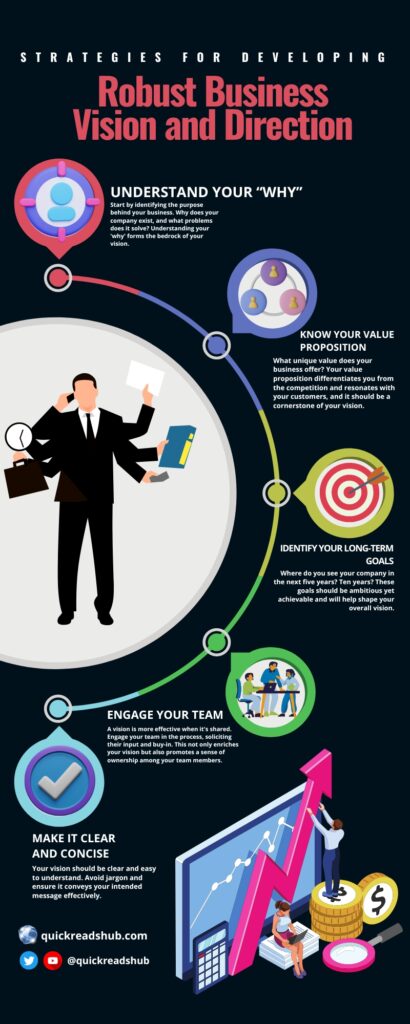The Importance of Effective CEO Leadership for Attracting Investments

Navigating the ever-growing world of economic growth and the unpredictable landscape of business requires strong CEO leadership. As small business owners, startup founders, or seasoned entrepreneurs, we face the constant pressures to perform, innovate, lead, and inspire. Cultivating top CEO leadership qualities is crucial for attracting investments and driving innovation. In this blog, we will explore the significance of these qualities and provide insights and strategies to help you excel in your role as a CEO.
Addressing Pain Points: Crystallizing Vision, Motivating Teams, and Making Decisions

Inspiring teamwork and creativity to attract potential investors.
Let’s address the pain points you may be experiencing. Are you struggling to define a compelling vision that resonates with potential investors? Or finding it challenging to motivate and empower your team, creating an environment that captivates investors and fosters productivity? Decision-making, too, can be a tightrope walk with every choice under scrutiny, whether it’s from your team or potential investors.
Building Trust, Confidence, and Effective Communication

Building trust and fostering effective communication for driving innovation.
Trust and confidence form the cornerstones of strong relationships with your team and investors. But how can you cultivate these intangible qualities? How do you effectively communicate, establishing an aura of trustworthiness that paves the way for fruitful relationships?
Embracing Change and Resilience in a Shifting Landscape

Embracing change and demonstrating resilience in a rapidly evolving landscape.
In today’s era of constant change, adaptability is no longer an option—it’s a necessity. How can you embrace change and make your business resilient and attractive to investors, even when faced with shifting landscapes?
Managing Overwhelm and Nurturing Self Amidst Demands
The overwhelming workload, tight deadlines, and sleepless nights can sometimes make you feel trapped. How can you effectively manage to overwhelm and steer your ship without losing sight of yourself and your goals?
Crafting a Compelling Pitch and Strengthening Financials

Raising capital can be an intimidating task, especially for first-time entrepreneurs. How can you craft a compelling pitch, present your vision, and convince potential investors to believe in you and your business? Additionally, how can you strengthen your financials, present them effectively, and attract investors who can propel your business to new heights?
Transforming Challenges into Opportunities
Challenges are stepping stones to growth. In the following sections, we will delve into these pain points, offering valuable insights, practical advice, and effective strategies to help you cultivate the top CEO leadership qualities that attract investments and drive innovation.
Guiding Your Journey to Success
This blog aims to be your guiding light, illuminating your path and instilling confidence as you navigate your journey as a leader. Why should you continue reading? Because each line and every insight you gain brings you closer to becoming the leader you aspire to be—one who possesses the top CEO leadership qualities necessary for attracting investments, driving innovation, and steering your ship toward the shores of success. So, fasten your seatbelt and embark on a transformative voyage of leadership. Your journey begins now.
Understanding the Challenges
Navigating the business world can often feel like traversing a labyrinth, filled with twists and turns that pose unique challenges at every corner. Whether you’re a seasoned business professional, a passionate startup founder, or an ambitious entrepreneur, these hurdles often manifest as common pain points that can inhibit your growth and stifle your potential.
Let’s take a closer look at these challenges:
1. The Absence of Clear Direction and Vision: Without a well-defined path, even the most competent business professionals can lose their way. Developing a strategic vision that aligns with your company’s goals and values is crucial for success. It forms the basis of your pitch to potential investors, allowing them to see the potential in your venture.
2. Struggles to Motivate and Inspire Others: As a leader, your role extends beyond making decisions. You’re tasked with rallying your team and driving them toward a common goal. But motivating a diverse team can be challenging, and failing to do so can dampen productivity and potentially deter investors.
3. Decision-Making Paralysis: Leaders are often faced with tough decisions that can significantly impact their company. The pressure can lead to decision-making paralysis, which can stall progress and erode investor confidence.
4. Building Trust and Confidence: A lack of trust can fracture relationships and hinder progress. Leaders must strive to build trust with their teams, customers, and potential investors. Effective communication and transparency are key to cultivating trust and fostering positive relationships.
5. Adapting to Change: The business landscape is constantly evolving, requiring leaders to be agile and adaptable. Failure to do so can make the business less resilient and attractive to investors.
6. Overwhelming Workloads: The pressures of managing a business can lead to stress and burnout. Leaders need effective time and stress management techniques to maintain their productivity and ensure their personal well-being, which can indirectly influence their company’s success and attractiveness to investors.
7. Raising Capital: For first-time entrepreneurs or those with less experience, securing funding can be a daunting task. A compelling pitch and confident presentation are key to attracting potential investors.
8. Team Structure and Vision: Investors prefer companies with a clear vision and a competent team. Leaders need to articulate their vision effectively and build a strong team that can execute it.
9. Financial Stability: A strong financial foundation is crucial for attracting investment. Leaders need to understand how to present their financials effectively to potential investors.
10. Demonstrating Traction: Early success or potential is a key indicator for investors. Leaders must showcase their company’s traction effectively or find ways to gain more visibility in the investor community.
The recognition and understanding of these challenges is not a sign of weakness; rather, it is the first step towards overcoming them. By acknowledging these pain points, you can devise effective strategies to address them, thereby enhancing your leadership skills and making your company more attractive to investors. This isn’t just about surviving in the business world – it’s about thriving, growing, and leaving a lasting impact.
Lack of Clear Direction and Vision
Imagine embarking on a journey without a destination in mind or a map to guide you. The path ahead would be fraught with uncertainty, hindering progress and leaving you susceptible to potential pitfalls. The world of business is no different. Without a clear direction and vision, it’s easy to lose sight of what you’re striving for, diluting your company’s appeal to potential investors.

The Importance of a Clear Vision in Leadership
A clear vision is akin to a beacon, guiding your business through the tumultuous seas of the marketplace. It provides a sense of purpose, aligns your team’s efforts, and sets the foundation for strategic decision-making. It’s the story you tell your stakeholders, a narrative that encapsulates your aspirations, values, and the impact you want to create.
For potential investors, your vision is a window into the future of your business. It demonstrates your ambition, strategic thinking, and ability to plan ahead, all key qualities that can inspire confidence and pique your investor’s interest.

Strategies for Developing a Robust Business Vision and Direction

Crafting a compelling vision requires introspection, strategic thinking, and a deep understanding of your business landscape. Here are some strategies to get you started:
1. Understand Your “Why”: Start by identifying the purpose behind your business. Why does your company exist, and what problems does it solve? Understanding your ‘why’ forms the bedrock of your vision.
2. Know Your Value Proposition: What unique value does your business offer? Your value proposition differentiates you from the competition and resonates with your customers, and it should be a cornerstone of your vision.
3. Identify Your Long-Term Goals: Where do you see your company in the next five years? Ten years? These goals should be ambitious yet achievable and will help shape your overall vision.
4. Engage Your Team: A vision is more effective when it’s shared. Engage your team in the process, soliciting their input and buy-in. This not only enriches your vision but also promotes a sense of ownership among your team members.
5. Make It Clear and Concise: Your vision should be clear and easy to understand. Avoid jargon and ensure it conveys your intended message effectively.
Actionable Item: Take some time to reflect on your company’s mission and long-term goals. Write a mission statement that encapsulates your purpose, values, and vision for the future. This will serve as a compass, guiding your strategic decisions and informing your approach to leadership.
Key Takeaway: A clear vision is more than just a statement; it’s a roadmap for success, a rallying cry that motivates your team, and a signal to potential investors about your company’s potential. By crafting a compelling vision, you’re not only setting a course for your company’s future, but you’re also enhancing its appeal to those who can help accelerate your journey.
Inspiring and Motivating Others
Have you ever wondered what sets apart good leaders from great ones? It’s often their ability to inspire and motivate those around them. As a CEO, your energy and enthusiasm become the fuel that powers your team’s productivity and commitment.

The Crucial Role of Motivation and Inspiration in Leadership
Being a CEO is about more than making strategic decisions and managing resources. It’s about creating an environment where your team feels inspired to give their best every day. An inspiring leader not only boosts team morale but also fosters a positive work culture that attracts investors.
When investors see a motivated team, they see a company that’s more likely to innovate, adapt, and succeed. They see a CEO who can rally their troops towards a shared vision and who can create an environment conducive to growth.
Techniques to Foster a Positive Work Culture and Boost Productivity
Creating an inspiring work environment isn’t an overnight process. It requires deliberate efforts, strategic thinking, and a deep understanding of your team’s dynamics. Here are some strategies that can help:
1. Communicate Effectively: Keep your team informed about company updates, future plans, and their role in achieving the company’s goals. Effective communication fosters a sense of transparency and inclusion.
2. Recognize and Reward Achievements: Acknowledging your team’s hard work and achievements boosts morale and motivation. It shows that you appreciate their efforts and value their contribution.
3. Encourage Innovation: Encourage your team to think outside the box and bring new ideas to the table. An innovative culture stimulates creativity and keeps your team engaged.
4. Promote Work-Life Balance: Respect your team’s personal time and promote a healthy work-life balance. This not only reduces stress but also enhances productivity in the long run.
5. Lead by Example: As a CEO, your actions set the tone for your company’s culture. Show your team the values and behavior you expect from them by embodying those yourself.
Actionable Item: Start implementing regular team meetings where you share company updates and recognize individual and team achievements. This simple step can go a long way in fostering a positive work culture and boosting team motivation.
Key Takeaway: As a CEO, your ability to inspire and motivate your team is a key determinant of your company’s success. A motivated team is more productive, more innovative, and more resilient – qualities that are sure to catch an investor’s eye. So, step up and become the inspirational leader your team needs. Not only will you boost your team’s morale and productivity, but you’ll also make your company more attractive to potential investors.
Decision Making: A Cornerstone of Effective Leadership

In the world of business, each day is filled with decisions. Some are small and seemingly inconsequential, while others can have far-reaching impacts on your company’s future. As a CEO, your decision-making skills are not only crucial for steering your company toward success but also for inspiring confidence in your investors.
The Role of Decision-Making in Leadership and Attracting Investments
An effective CEO is a decisive one. Your ability to make sound, timely decisions can determine your company’s strategic direction, operational efficiency, and overall success. It also signals to your investors that you have a clear understanding of your business landscape and that you’re capable of leading your company through challenges and opportunities alike.
Investors are drawn to leaders who demonstrate thoughtful decision-making processes. They’re looking for CEOs who can navigate uncertainty, evaluate risks, and seize opportunities – all while keeping their company’s vision in sight.
Tools and Methods to Improve Decision-Making Skills
Improving your decision-making skills is a journey that requires practice, patience, and the right tools. Here are some strategies and methods that can help:
1. SWOT Analysis: This framework allows you to evaluate your company’s Strengths, Weaknesses, Opportunities, and Threats, providing a comprehensive view of your business landscape to inform your decisions.
2. Decision Matrix Analysis: This tool helps you evaluate and prioritize your options based on their potential impacts. It’s especially useful when you’re faced with complex decisions involving multiple variables.
3. Cost-Benefit Analysis: This method helps you weigh the potential costs and benefits of a decision, making it easier to choose the option that offers the greatest advantage to your company.
4. Scenario Planning: This technique involves imagining different scenarios that could result from your decisions. It allows you to anticipate potential outcomes and prepare for them.
Actionable Item: Start utilizing decision-making frameworks such as SWOT analysis or Decision Matrix Analysis in your day-to-day business decisions. These tools can provide structure to your decision-making process and help you make more informed choices.
Key Takeaway: Effective decision-making is a powerful leadership skill that can guide your company toward its goals and instill confidence in your investors. By improving your decision-making skills, you can become a more effective CEO and make your company more attractive to potential investors.
Building Trust and Confidence: The Bedrock of Successful Leadership
Trust and confidence are not just buzzwords; they’re the lifeblood of any successful relationship. As a CEO, your ability to cultivate these qualities can profoundly impact your relationships with your team, your customers, and your investors.
The Role of Trust in Leadership and Investor Relations
Trust is the foundation of any successful leadership. Your team looks to you for guidance and direction, and they need to trust in your abilities and judgment. Similarly, investors need to trust that you have the vision, the skills, and the integrity to lead your company to success.
Harvard Business Review [emphasizes the importance of trust] effective management. Investors are often drawn to businesses where the CEO has built a strong culture of trust. A CEO who is trusted by their team is more likely to create an environment of productivity, innovation, and resilience, all of which are attractive qualities to investors.

Tips to Improve Communication and Interpersonal Skills
Building trust and confidence isn’t about grand gestures; it’s about consistently demonstrating your reliability, sincerity, and competence. Here are some tips to help you develop these qualities:
1. Open and Regular Communication: Transparency fosters trust. Regularly update your team and investors about company developments. Be open about challenges and how you plan to address them.
2. Active Listening: Show genuine interest in others’ ideas and feedback. This not only helps build trust but can also provide valuable insights.
3. Consistency: Be consistent in your actions, decisions, and communication. This helps others know what to expect from you, building their confidence in your leadership.
4. Admitting Mistakes: Nobody is perfect. If you make a mistake, own up to it. This shows integrity and earns respect.
5. Shared Success: Celebrate successes as a team achievement. This fosters a sense of unity and mutual trust.
This advice aligns with expert insights shared by [Forbes], highlighting the importance of these qualities for effective leadership.
Actionable Item: Establish regular communication channels with your team and investors. This could be weekly team meetings, monthly investor updates, or simply an open-door policy encouraging open dialogue.
Key Takeaway: Trust and confidence are not just important, they’re essential. As a CEO, building trust can foster strong relationships, create a positive work culture, and significantly influence investors’ decisions.
Adapting to Change: Navigating the Seas of Uncertainty
In the realm of business, change is the only constant. As a CEO, your ability to adapt and lead your company through fluctuating market conditions is a vital attribute that investors seek.

The Significance of Adaptability in the Evolving Business Landscape
Today’s business landscape is akin to a fast-paced, ever-evolving organism. Market trends change, consumer preferences shift, and technology advances at an unprecedented rate. As a leader, your adaptability can mean the difference between navigating these changes successfully or being left behind.
A study from the [Harvard Business Review] highlights that adaptability is now seen as a competitive advantage in business. Investors are drawn to CEOs who can swiftly adapt their business strategies to fit changing market conditions, making adaptability a key leadership quality in attracting investments.
Strategies to Enhance Business Agility and Resilience
While adaptability might seem like an innate trait, it can be nurtured and developed. Here are some strategies to enhance your business agility and resilience:
1. Stay Informed: Keep a pulse on industry trends and market changes. Tools such as Google Alerts and industry reports can be invaluable.
2. Encourage Innovation: Foster a culture of innovation within your team. Fresh ideas can lead to adaptable solutions.
3. Embrace Technology: Technological advancements can offer new opportunities and efficiencies. Stay open to integrating suitable technologies into your business processes.
4. Learn from the Past: Reflect on past challenges and how they were handled. Use these experiences to inform future decisions.
5. Plan for Change: Develop contingency plans for potential changes in the market. This ensures you’re prepared for different scenarios.
These strategies align with the insights shared by [McKinsey & Company], emphasizing the role of agility in building successful organizations.
Actionable Item: Start developing a contingency plan for your company considering potential market changes. This could involve brainstorming with your team, conducting a SWOT analysis, or consulting with industry experts.
Key Takeaway: An adaptable CEO is like a skilled sailor, able to navigate the ship through stormy seas and uncharted waters. This quality not only makes your business resilient but also enhances its attractiveness to investors.
Managing Overwhelm
Running a company is no easy feat, with a plethora of responsibilities constantly clamoring for your attention. It’s hardly surprising that stress levels can skyrocket. From my research, a study by Harvard Business Review suggests that CEOs work an average of 62.5 hours a week, almost 50% more than a typical full-time employee.
The Emotional Pressure
But the overwhelm doesn’t stem from the workload alone. The emotional burden of decision-making, the strain of meeting expectations, and the responsibility of leading a team can also contribute to a pervasive sense of overwhelm.
Navigating Through the Overwhelm
Successful leaders, however, have found ways to navigate this overwhelm. Their secret? Effective time management and delegation. Prioritizing tasks and knowing when to entrust responsibilities to others are crucial aspects of maintaining balance and productivity.
Real-world Example: Elon Musk’s Time-Management Strategy
Consider the case of Elon Musk, CEO of SpaceX and Tesla. Juggling multiple businesses, Musk is renowned for his time management skills. In an article I read, Musk segments his time into five-minute slots, a technique known as time-blocking. This focused approach allows him to tackle one task at a time, reducing the sense of overwhelm and boosting productivity.
Actionable Item:
As an actionable step, you could emulate Musk’s strategy. Begin by identifying your top priorities and delegate tasks where appropriate. Then, consider using a time management tool such as time-blocking or the Eisenhower Box, a decision-making tool that helps prioritize tasks based on urgency and importance.
Key Takeaway: The Art of Managing Overwhelm
Effectively managing to overwhelm is more than a survival strategy; it’s an art that can boost productivity and maintain balance. By mastering this skill, you improve not only your well-being but also your company’s performance. A calm and focused leader is more likely to make sound decisions, inspire their team, and consequently, appear more appealing to potential investors.
Navigating Capital Raising
The journey of raising capital and attracting investments is often a daunting challenge for many CEOs, especially in the early stages of a startup. The process is complex, requiring not only a comprehensive understanding of financial principles but also a keen awareness of investor psychology.
Securing funding involves convincing potential investors that your company is a worthy investment. This means you need to communicate the value proposition of your business effectively, demonstrating not only its potential for profitability but also how it fits into the wider market landscape.
From what I’ve studied in various sources such as Inc. and Entrepreneur, a well-crafted business plan can be a powerful tool in this process. It should include a detailed overview of your business model, market analysis, marketing strategy, financial projections, and management structure.
In addition to a comprehensive business plan, CEOs need to create a compelling elevator pitch. This short, persuasive speech should succinctly explain your business concept and its unique selling point. It’s often your first opportunity to pique an investor’s interest, so it should be polished and compelling.

Actionable Item: Start by crafting a compelling elevator pitch that encapsulates the essence of your business. Then, prepare a detailed business plan that covers all aspects of your venture, from your unique selling proposition to your financial projections.
Key Takeaway: The process of raising capital can be challenging, but thorough preparation and strong presentation skills can significantly improve your chances of securing investment. By mastering these top CEO qualities for attracting investments, you’re more likely to win over investors and secure the funding you need to propel your business forward.
Building a Strong Team Structure

The importance of having a competent team cannot be understated when it comes to attracting investors. As Jim Collins, the author of the best-selling book “Good to Great” noted, “First who, then what” – great vision without great people is irrelevant1. Investors are not just investing in your idea, but also in your team’s ability to execute that idea.
Strategies for Building a Strong Team
Building a robust team that can execute the vision requires both strategy and empathy. Start by identifying the key skills needed to bring your vision to life. Then, look for people who are not just experts in their field, but are also passionate about your vision. As you grow, foster a culture of continuous learning and improvement. This could involve providing opportunities for professional development or implementing a mentorship program.
Actionable Item: Regularly evaluate team performance and provide opportunities for professional development.
Creating a culture of feedback is essential. Regularly evaluating team performance helps identify areas for improvement and growth. It also provides an opportunity to recognize and reward hard work, which can boost morale and productivity. Providing opportunities for professional development shows that you value your team members and are invested in their growth. This can lead to increased loyalty and a stronger team overall.
Key Takeaway: A strong team is an invaluable asset that can execute the company’s vision and appeal to investors.
Remember, a strong team doesn’t just execute tasks efficiently; they also bring diverse perspectives that can drive innovation. And this is what investors look for – a team that can pivot, adapt, and drive growth even in the face of challenges.
Strengthening Financials
In the grand theatre of business, a CEO plays a multitude of roles. One such pivotal role is ensuring the company’s financial health. A robust financial position not only enables a company to weather economic downturns but also serves as a key factor in attracting potential investors.
As Warren Buffet, one of the most successful investors in the world, once said, “It’s far better to buy a wonderful company at a fair price than a fair company at a wonderful price.”1 This statement underscores the importance of solid financials in the eyes of investors.
The Role of Strong Financials
A company’s financials are like its vital signs, providing a snapshot of its health and performance. Investors scrutinize these figures, looking for signs of growth potential and financial stability. A healthy balance sheet, strong cash flows, and promising revenue forecasts can significantly enhance a company’s appeal to investors.
Improving Financial Performance and Presentation
Improving your company’s financial performance is a process that requires diligent planning, implementation, and monitoring. Here are some strategies to consider:
Cost Management: Regularly review your company’s expenses to identify areas where you can reduce costs without compromising product or service quality.
Revenue Enhancement: Explore new revenue streams, improve pricing strategies, and enhance sales and marketing efforts to boost revenues.
Financial Forecasting: Accurate financial forecasting can help you anticipate future expenses and revenues, allowing you to plan and make informed decisions.
Financial Reporting: Transparent and professional financial reporting is essential to establish credibility with investors. Regularly share updates about your company’s financial status, ensuring the information is accurate and easy to understand.

ACTIONABLE ITEM
Implement regular financial reviews to identify areas for improvement. Consider utilizing financial management tools, such as QuickBooks or FreshBooks, to streamline your financial processes and provide clear, accurate financial reports.
KEY TAKEAWAY
Solid financial health is not just a desirable trait for a company; it’s a non-negotiable attribute that investors seek. A company with strong financials demonstrates viability and growth potential, making it a prime candidate for investment. Remember, your financials are more than numbers on a page – they’re a reflection of your company’s health, potential, and the value you offer to investors.
SOURCES: https://www.forbes.com/sites/michaelkay/2019/10/29/six-steps-to-simplifying-your-money-life
Demonstrating Traction: Showcasing the Early Wins
Have you ever found yourself mesmerized by the growth trajectory of a rocket launch? The anticipation, the countdown, the lift-off, and then, the exhilarating climb. In the business world, demonstrating traction is akin to showcasing that exciting lift-off and ascent. It’s about exhibiting potential and early success, capturing the attention of spectators, and, most importantly, potential investors.
The Importance of Showing Potential and Early Success
Traction, in business terms, refers to the progress of a start-up company and the momentum it’s building. It’s an indication of the company’s potential and a testament to the capabilities of the CEO and the team.
As Reid Hoffman, co-founder of LinkedIn, aptly put it, “In founding a start-up, you throw yourself off a cliff and build an airplane on the way down.” This quote highlights the reality that early-stage companies often face steep odds. But demonstrating traction—building that airplane successfully—becomes a powerful signal of potential.
Strategies to Showcase Company Traction and Gain Visibility
Establish Key Performance Indicators (KPIs): KPIs provide a quantifiable measure of success. They might include metrics like monthly active users, customer acquisition cost, or revenue growth.
Share Success Stories: If your product or service has helped a customer solve a problem, share that story. Customer testimonials can be powerful indicators of your company’s value.
Highlight Partnerships: If your company has established partnerships with other businesses or industry influencers, these collaborations can signal credibility and momentum.
Demonstrate Financial Health: As we discussed in the previous section, strong financials are attractive to investors. Regularly share updates about your company’s financial status.
Leverage Media and Public Relations: Use media platforms to share your company’s milestones and achievements. A feature in a reputable business publication or an appearance on a popular podcast can significantly enhance visibility.
ACTIONABLE ITEM:
Identify the key metrics that most accurately reflect your company’s progress and success. Regularly update these figures and make them easily accessible to potential investors. Also, consider creating a “traction slide” for your pitch deck to visually represent your company’s growth and momentum.
Key Takeaway
Demonstrating traction shows investors that your company isn’t just a concept—it’s a growing entity moving toward success. It’s about showcasing not just where you are, but where you’re heading. In the end, these indicators of potential and early success can significantly enhance your company’s attractiveness to investors.
So, whether you’re just lifting off or already climbing toward the stars, remember to let your traction be visible. After all, everyone loves a good rocket launch!
Footnotes:
Investopedia: Traction
Forbes: Reid Hoffman
8 Startup KPIs You Need to Start Tracking
What Every New Entrepreneur Needs To Know About PR
Reputation Management: The Art of Shaping Perception

Picture this: You’re at a party and someone you’ve never met approaches you. They’ve heard good things about you, and they’re eager to know more. Now imagine the opposite: they’ve heard negative things, and they’re hesitant or even dismissive. In both scenarios, your reputation preceded you, shaping others’ perceptions before you even had a chance to introduce yourself.
In the world of business, the story isn’t much different. A company’s reputation significantly influences its attractiveness to potential investors.
The Impact of Negative Reputation on Attracting Investments
Reputation is a powerful asset – or liability – for any business. It’s like a magnifying glass through which investors view a company. A positive reputation can amplify achievements, while a negative one can magnify flaws.
In the digital age, where information spreads faster than wildfire, a company’s reputation can change overnight. A single negative news article or an adverse customer review can seriously damage a company’s image. For potential investors, a company with a tarnished reputation presents a risk, potentially leading to reluctant investment decisions.
Methods to Improve Company Reputation and Mitigate Negative Press
How can you navigate this challenging landscape? Here are some methods:
- Proactive Online Presence Management: Regularly monitor your company’s online presence, responding promptly and professionally to any negative feedback.
- Transparency: Be open and honest about your company’s operations and challenges. This builds trust with stakeholders, including potential investors.
- Corporate Social Responsibility: Engage in initiatives that give back to the community. This can significantly enhance your company’s reputation.
- Media Relations: Maintain good relationships with the media. In times of crisis, these relationships can help control the narrative.
- Employee Advocacy: Encourage employees to be brand ambassadors. Their positive testimonials can improve your company’s reputation.
ACTIONABLE ITEM: Begin by conducting an audit of your company’s online presence. Address any negative feedback or press promptly and professionally. Remember, the goal is to not only manage but to shape your company’s reputation actively.
Key Takeaway: In the end, a positive reputation can significantly boost a company’s chances of attracting investment. It’s the invisible force that opens doors, builds trust, and paves the way for growth. As Warren Buffett once said, “It takes 20 years to build a reputation and five minutes to ruin it. If you think about that, you’ll do things differently.”
The Transition from Founder to CEO: A Journey of Transformation
Have you ever watched a caterpillar transform into a butterfly? The process, known as metamorphosis, involves significant changes. The caterpillar has to shed its old form to embrace a new identity. The transition from a founder to a CEO in a business context mirrors this natural phenomenon. It’s a journey of transformation that requires a shift in mindset and the development of new skills.
The Challenges of Transitioning from a Founder to a CEO
As a founder, you might have started with a passion, an idea, and the determination to bring it to life. You wore multiple hats, made critical decisions, and were deeply involved in every aspect of the business. However, as your startup grows, a new role emerges – that of the CEO.
This transition can be challenging for several reasons:
- Shifting Roles and Responsibilities: As a CEO, you need to step back from daily operations and focus more on strategic decision-making, building partnerships, and attracting investments.
- Delegation: Founders often struggle with delegation, finding it hard to let go of tasks they used to manage. However, as a CEO, delegation becomes a vital skill.
- Developing Leadership Skills: Being a CEO requires strong leadership skills, including communication, decision-making, and team management.
Cultivating Necessary CEO Qualities
So, how can you prepare for this transition? Here are a few tips:
- Embrace Continuous Learning: CEOs need a wide range of skills and knowledge. Regularly invest time in expanding your knowledge and improving your skills.
- Seek Mentorship: A mentor who has experienced this transition can provide valuable insights and guidance.
- Develop Emotional Intelligence: As a CEO, you’ll need to manage relationships with employees, investors, and stakeholders. Emotional intelligence can help you navigate these interactions effectively.
- Foster a Strong Team: Build a competent team that you can trust to manage day-to-day operations.
ACTIONABLE ITEM: Consider seeking mentorship or enrolling in leadership training programs to help you develop the necessary CEO skills. Remember, like the caterpillar, you’re not just growing – you’re transforming.
Key Takeaway: Transitioning from founder to CEO is a significant step in a company’s growth journey. It’s about more than just a change in title – it requires a shift in mindset, a new set of skills, and the courage to embrace a new identity. It’s about becoming the butterfly that can guide the company to new heights.
Establishing Credibility: A Non-Negotiable Trait for CEOs
In the world of business, credibility carries significant weight. A credible CEO is like a lighthouse in a storm, providing reliable guidance and assurance amidst uncertainty. In this section, we’ll delve into the importance of credibility in leadership and how you can establish it as a CEO.
The Need for Credibility and Validation in Leadership
Credibility is the foundation of effective leadership. As a CEO, your credibility influences your team’s trust in your vision, your stakeholders’ confidence in your decisions, and your investors’ faith in your promises. A credible CEO not only attracts investments but also inspires employees, motivates the team, builds partnerships, and fosters a positive brand image. In the words of leadership expert James M. Kouzes, “If people don’t believe in the messenger, they won’t believe the message.
How to Establish Credibility as a CEO
Building credibility doesn’t happen overnight. It requires consistency, transparency, and integrity. Here are a few strategies to consider:
- Showcase Your Expertise: Share your knowledge and insights through thought leadership content, such as blogs, podcasts, or speaking engagements. This not only positions you as an expert in your field but also builds trust with your audience. (Entrepreneur)
- Lead by Example: Demonstrate the values and work ethic you expect from your team. This builds respect and promotes a positive company culture.
- Communicate Openly: Transparency in communication fosters trust. Regularly update your team and stakeholders about the company’s progress, challenges, and future plans.
- Admit and Learn from Mistakes: Even CEOs make mistakes. Admitting them openly and learning from them can actually enhance your credibility. (Inc.)
ACTIONABLE ITEM: Start building your credibility today. Write a blog post or host a podcast episode on a topic you’re passionate about and share your unique insights.
Key Takeaway: Establishing credibility as a CEO is a crucial factor in attracting investment. Credibility doesn’t just add seriousness to your venture – it’s a testament to your leadership and the potential success of your company. In the end, credibility can be the beacon that guides your venture toward the shores of success.
Navigating Growth and Scaling: The Trials and Triumphs
Business growth and scaling represent a pivotal stage for any organization. The challenges that surface during this phase put the CEO’s leadership skills under the microscope. Effective navigation through this stage can set a solid foundation for future business success. Let’s delve into these challenges and understand how the top qualities of successful CEOs can be game-changers in these situations.
The Challenges of Business Growth and Scaling
As businesses progress from a startup phase to a growth phase, they often encounter a host of challenges. The ability to maintain the quality of products or services while increasing output, sustaining the company culture amidst rapid expansion, managing the increasing complexity of operations, and ensuring financial sustainability are among the hurdles that businesses commonly face according to Inc. These hurdles can put a strain on the company’s resources and test the mettle of its leadership.

Harnessing CEO Qualities for Growth and Scaling
Successful CEOs possess a unique blend of qualities that enable them to steer their organizations effectively through the complexities of growth and scaling. Here’s how these qualities come into play:
- Strategic Thinking: CEOs need to devise and implement growth strategies that consider multiple variables, including market conditions, competition, resources, and the capabilities of their teams. Strategic thinking aids in identifying lucrative growth opportunities and potential risks.
- Decisiveness: Rapid growth demands quick yet well-informed decision-making. A CEO should be able to make tough decisions that align with the company’s long-term vision and the realities of the present moment.
- Adaptability: As businesses scale, changes become inevitable. CEOs need to demonstrate adaptability to effectively navigate the ever-changing business landscape.
- People Management: CEOs must ensure that their teams remain motivated, aligned, and productive during growth phases. This requires strong people management skills, including empathy, effective communication, and delegation.
- Financial Acumen: With growth comes increased financial complexity. CEOs must have a sound understanding of their financial metrics to make informed decisions and ensure the financial sustainability of the business.
Actionable Item
Reflect on these qualities and identify areas for improvement. Consider seeking mentorship or undergoing leadership training to hone these skills. In parallel, develop a growth and scaling strategy that takes into account market conditions, available resources, and team capabilities.
Key Takeaway
Growth and scaling bring a unique set of challenges that test a CEO’s leadership skills. However, by nurturing strategic thinking, decisiveness, adaptability, people management skills, and financial acumen, you can effectively navigate these challenges. Understanding how to steer through growth and scaling hurdles is not just a skill—it’s a compass that guides your business toward enduring success.
Building Networks: Your Key to Investment Opportunities
In the realm of business leadership, networking is a critical component that can unlock a wealth of opportunities. It plays a significant role in attracting investments, fostering partnerships, and gaining industry insights. The strength of a CEO’s network can be a determining factor in a company’s growth trajectory.
The Power of Networking in Attracting Investments
Networking, at its core, is about building and nurturing relationships. In the context of investment, these relationships can provide a platform for CEOs to showcase their company’s potential and worth. Investors are more likely to invest in companies they are familiar with and trust, and networking provides the opportunity to build this familiarity and trust according to Harvard Business Review.
Moreover, networking can open doors to a diverse group of investors, allowing CEOs to pitch to those who are most likely to be interested in their particular business. A wide network can also provide CEOs with insights into investors’ preferences and concerns, enabling them to tailor their pitches effectively.
Nurturing Networks with Potential Investors
Building a robust network isn’t an overnight task; it requires strategic planning and sustained effort. Here are some strategies to help you cultivate your network:
- Attend Industry Events: Conferences, seminars, and industry gatherings are excellent platforms to meet potential investors. Engage in meaningful conversations and express genuine interest in others’ perspectives.
- Leverage Social Media: Platforms like LinkedIn can be a powerful tool to connect with investors. Participate in relevant discussions, share your insights, and establish your presence.
- Join Professional Organizations: Membership in relevant professional organizations can offer networking opportunities and provide access to resources that can aid in your networking endeavors.
- Follow Up: After meeting potential investors, follow up with them to express your interest in exploring possible opportunities. Personalized communication can help you stand out and nurture these relationships over time.
Actionable Item
Start building your network today. Attend industry events, leverage the power of social media, and join professional organizations that align with your business interests. Remember, the goal is to build meaningful relationships that are mutually beneficial.
Key Takeaway
A robust network is a treasure trove of potential investors, partnerships, and mentors. Building and nurturing this network can significantly facilitate your journey toward attracting investment. Remember, every connection you make is a step closer to your next investment opportunity.
Competing in the Market: CEO Qualities that Differentiate and Attract Investments
In an ever-evolving business landscape marked by intense competition, standing out can be a daunting task for many CEOs. However, certain CEO qualities can serve as the catalyst to differentiate a business and make it more appealing to investors. Let’s delve into these challenges and discuss how a CEO can turn the tides in their favor.
The Market Competition Conundrum
The marketplace is not for the faint-hearted. It’s a battleground where only the fittest survive, and competition can be fierce. As per a study by McKinsey, a mere 20% of companies achieve sustained growth. The challenge becomes even more significant when attempting to attract investors in such an environment.
CEO Qualities: The Differentiating Factors
So, how can a CEO rise above the competition? The answer lies in exhibiting certain top CEO leadership qualities and making strategic decisions that set their company apart.
- Vision: A CEO with a clear, compelling vision can guide their company towards unique opportunities that others may overlook. A visionary CEO sees beyond the present and drives innovation, making their company a potential game-changer in the industry.
- Resilience: The journey of a CEO isn’t always smooth. There will be setbacks, but a resilient CEO can navigate these challenges, learning, and growing from each experience. This quality is particularly attractive to investors, as it demonstrates the CEO’s capability to steer the company through tough times.
- Strong Decision-making: The decisions a CEO makes can significantly impact a company’s standing in the market. A CEO who can make tough calls, even under pressure, shows potential investors that they’re capable of leading the company to success.
Actionable Item: Harness Your Unique Selling Proposition (USP)
To rise above the competition, it’s crucial to identify and communicate your Unique Selling Proposition (USP) clearly in your marketing efforts. Your USP is what sets you apart from the competition – it’s the reason why customers should choose you over others. According to a Forbes article, a well-defined USP can help your business stand out in a crowded market and attract more customers, and by extension, more investors.
Key Takeaway
In a competitive market, differentiating yourself can make your company more appealing to investors. The journey might be challenging, but with the right CEO qualities and a clear USP, you can pave the way for business success and investment attraction.
Addressing the Fear of Failure: Cultivating CEO Qualities for Resilience and Success
The road to entrepreneurship is often paved with uncertainties. One constant, often overwhelming, companion on this journey is the fear of business failure. This fear can be paralyzing and can deter even the most ambitious entrepreneurs from pursuing their dreams. But what if we told you that this fear can be harnessed, transformed, and even be turned into a catalyst for success? Let’s dive into how cultivating certain CEO qualities can help reduce the risk of failure and lead to growth and resilience.
The Fear of Failure: An Entrepreneur’s Constant Companion
A study published in the Journal of Business Venturing found that fear of failure is one of the main factors that discourage individuals from starting a business. It’s a gnawing concern that can hinder decision-making, risk-taking, and ultimately, business growth.
CEO Qualities: Turning Fear into Fuel
Rather than viewing fear as a roadblock, successful CEOs often leverage this fear as a powerful motivator. Here’s how:
- Embrace a Growth Mindset: CEOs who adopt a growth mindset view failure not as a catastrophe but as a valuable lesson. They see it as an opportunity to learn, grow, and improve their strategies. According to psychologist Carol Dweck, author of Mindset: The New Psychology of Success, individuals with a growth mindset are more likely to bounce back from failure and achieve their goals.
- Resilience: This is one of the prime CEO leadership traits. Being resilient means having the mental and emotional strength to cope with and recover from setbacks. A resilient CEO can stay focused and optimistic, even in the face of adversity, which can instill confidence in potential investors.
- Risk Management: Effective risk management is a critical CEO quality for attracting investments. By identifying, analyzing, and preparing for risks, CEOs can make more informed decisions, reducing the likelihood of failure.
Actionable Item: Learn from Failures and Challenges
One practical step to address the fear of failure is to regularly review and learn from your failures and challenges. This practice can provide invaluable insights and help you make more informed decisions in the future. Remember, failure is not the opposite of success, but a stepping stone towards it.
Key Takeaway
Embracing failure as a learning opportunity can lead to growth and resilience. These CEO qualities are attractive to investors, as they indicate a leader’s ability to navigate through tough times and steer the business toward success. As Henry Ford once said, “Failure is simply the opportunity to begin again, this time more intelligently.” In this context, addressing and overcoming the fear of failure can be the first step toward turning your entrepreneurial dreams into reality.
Conclusion: The Power of Effective CEO Leadership in Attracting Investments
In the intricate dance of business and leadership, we’ve traversed the terrain of top CEO leadership qualities and their impact on attracting investments, driving innovation, and securing the future of organizations. We examined various challenges that CEOs face, from securing funding to scaling a business, and discussed how certain CEO qualities can turn these obstacles into opportunities.
Let’s recap the main points:
- Navigating Capital Raising: A CEO’s preparation and presentation skills can significantly improve the chances of securing funding.
- Building a Strong Team Structure: A competent team is the foundation for executing the company’s vision and appealing to investors.
- Strengthening Financials: Solid financial health illustrates a company’s viability and potential for growth.
- Demonstrating Traction: Showcasing early success is a clear indication to investors of a company’s potential.
- Reputation Management: A positive reputation can significantly improve a company’s chances of attracting investment.
- The Transition from Founder to CEO: This requires a shift in mindset and the development of new skills.
- Establishing Credibility: Credibility adds seriousness to the venture, increasing the likelihood of attracting investment.
- Navigating Growth and Scaling: Understanding how to navigate growth and scaling challenges can pave the way for business success.
- Building Networks: A robust network can provide valuable connections with potential investors, partnerships, and mentors.
- Competing in the Market: Differentiating yourself in a competitive market can make your company more appealing to investors.
- Addressing the Fear of Failure: Embracing failure as a learning opportunity can lead to growth and resilience, qualities that are attractive to investors.
These insights not only shed light on the prime CEO leadership characteristics but also underscore the importance of these qualities in the journey toward success. As we’ve seen, a CEO’s qualities can play a pivotal role in attracting investments, competing in the market, and ultimately driving innovation.
From what I’ve studied and researched from credible sources such as Harvard Business Review, Forbes, and the Journal of Business Venturing, it’s clear that the CEO’s role is not just about managing a company; it’s about inspiring confidence, embodying the organization’s values, and leading by example.
In conclusion, effective CEO leadership goes beyond the bottom line. It’s about shaping a vision, creating a conducive environment for innovation, and building a resilient team that can weather the storms of business. These are the top qualities of successful CEOs that make them magnets for investments. By embracing these qualities, any aspiring or current CEO can significantly enhance their effectiveness and propel their company towards success.
Let’s Take This Journey Together
We’ve ventured through the landscape of effective CEO leadership and the vital role it plays in attracting investments. From demonstrating traction and managing reputation to mastering the transition from founder to CEO, cultivating credibility, navigating growth and scaling, building networks, standing out in a competitive market, and addressing the fear of failure – these are all critical aspects that play into your journey as a successful CEO.
As you tread this path, we would love to hear your insights, experiences, and questions. How are you applying these principles in your leadership journey? What challenges have you faced, and how have you overcome them? Sharing your thoughts not only benefits you but can also inspire and guide others on a similar journey. So, don’t hesitate to leave a comment below.
If you found value in this content, consider sharing it with your network. After all, wisdom grows through sharing.
We also encourage you to delve deeper into the resources provided in the curated reading list and to learn from the real-world applications in our case study deep dives. And remember, this is an ongoing journey. Leadership skills are not stagnant but evolve with time, experience, and knowledge.
Stay tuned for our upcoming posts, where we will continue to explore the fascinating world of leadership, entrepreneurship, and investment attraction. We’ll be discussing more strategies, sharing more insights, and providing more resources to support you on this journey.
Until then, keep learning, keep growing, and remember – great leadership isn’t just about running a successful business; it’s about making a positive impact on the world around you.
BONUSES: Expanding Your Leadership Horizons
Curated Reading List
Continuing on this path of leadership exploration, below is a specially curated reading list. Each resource offers invaluable insights into leadership qualities and strategies that have proven successful in various industries:
- “Good to Great: Why Some Companies Make the Leap… and Others Don’t” by Jim Collins: Collins presents a thoroughly researched discourse on how good, mediocre, and even bad companies can achieve enduring greatness. The book discusses the importance of a Level 5 leader – an executive who blends genuine personal humility with an intense professional will.
- “The Lean Startup” by Eric Ries: This book introduces the concept of the “Lean Startup” methodology, which promotes efficiency, flexibility, and market relevance. Ries emphasizes the significance of vision and forward-thinking in successful CEOs.
- “The Hard Thing About Hard Things: Building a Business When There Are No Easy Answers” by Ben Horowitz: Horowitz shares honest and humble advice on starting and running your own company. He provides insights into the tough decisions and lonely times all CEOs face and offers a reading list of his own.
- “The Five Dysfunctions of a Team: A Leadership Fable” by Patrick Lencioni: Lencioni reveals the basics of teamwork by wrapping them in a narrative. He provides actionable steps to identify and resolve common issues that hinder team performance.
- HBR’s 10 Must Reads on Leadership (with featured article “What Makes an Effective Executive,” by Peter F. Drucker): This compilation from Harvard Business Review offers diverse perspectives from respected experts on leadership, including qualities and actions needed for successful leadership.
Case Study Deep Dives
To provide more practical insights into the application of leadership qualities, here are two case studies that showcase how successful CEOs have leveraged their unique qualities to steer their companies to success:
- Satya Nadella at Microsoft: Nadella’s leadership at Microsoft offers a masterclass in transformational leadership. His emphasis on a growth mindset and cultural shift within the organization has revitalized Microsoft’s innovation.
- Indra Nooyi at PepsiCo: Nooyi’s tenure as CEO of PepsiCo was marked by her visionary leadership and a strong focus on sustainable long-term growth. Her “Performance with Purpose” initiative made PepsiCo a leader in corporate responsibility.
Through these resources and case studies, we can continue to learn from successful leaders, understanding that leadership is a journey that requires continual learning, adaptation, and growth. As these leaders demonstrate, embracing the key qualities of successful CEOs can significantly enhance your effectiveness and propel your company toward success.





